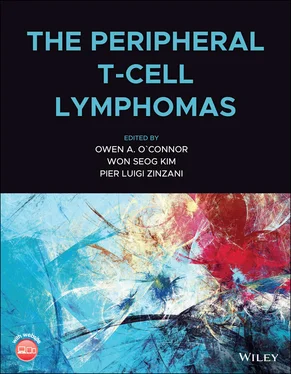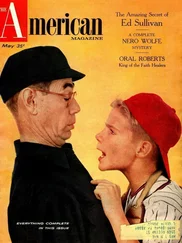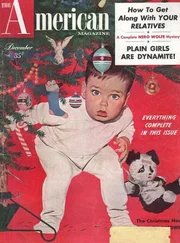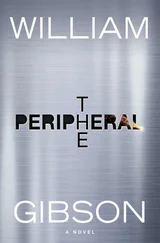Reads References 22 The Role of Autologous Stem‐cell Transplantation in Peripheral T‐cell Lymphomas Introduction Autologous Stem‐cell Transplantation in First Complete Remission Autologous Stem‐cell Transplantation in Relapsed/Refractory Disease Interpretation of Available Literature Identifying the Most Relevant Determinants for Survival among Patients with Peripheral T‐cell Lymphoma Undergoing Autologous Stem‐cell Transplantation Status of Response Prior to Autologous Stem‐cell Transplantation Risk of Stage Number of Prior Therapies and Refractory Disease Autologous Stem‐cell Transplantation on Specific Subtypes of Peripheral T‐cell Lymphoma Must reads References 23 Allogeneic Stem‐cell Transplantation Introduction Allogeneic Stem‐cell Transplantation for Relapsed and Refractory Disease (Focus on Nodal Hystotypes) Allogeneic Stem‐cell Transplantation as Consolidation of First Remission Allogeneic Stem‐cell Transplantation in Specific Subtypes Future Directions Must Reads References 24 Emerging Immunotherapy Approaches in Peripheral T‐cell Lymphomas Introduction Monoclonal Antibody Therapy Immunoconjugate‐Based Therapy for Peripheral T‐Cell Lymphoma Cell‐Mediated or Cellular Immunotherapy in Peripheral T‐Cell Lymphoma Challenges and Future Directions Must Reads References 25 Emerging New Small Molecules in Peripheral T‐cell Lymphomas Introduction Demethylating Agents Janus‐associated Kinase–Signal Transducers and Activators of Transcription and Spleen Tyrosine Kinase Inhibitors Phosphatidylinositol 3‐Kinase Inhibitors Miscellaneous Conclusion Must Reads References
10 Part V: Future Directions 26 The Value and Relevance of T‐cell Lymphoma Registries Introduction Population‐based Cancer Registries Retrospective Studies T‐cell Lymphoma Registries Future Directions Disclosures Must Reads References 27 Innovative Chemotherapy‐free Approaches for the Treatment of Peripheral T‐Cell Lymphoma Introduction Targeting the Peripheral T‐cell Lymphoma Epigenome Romidepsin Plus Pralatrexate Romidepsin Plus 5‐Azacytidine Romidepsin Plus Duvelisib Romidepsin Plus Lenalidomide Panobinostat and Bortezomib A Glance at the Future: Building on the Active Doublets Must Reads References 28 Global Collaborations Introduction The Global T‐cell Lymphoma Consortium Conclusion
11 Index
12 End User License Agreement
1 Chapter 2 Table 2.1 Main nodal and extranodal mature T‐cell neoplasms with summary of t...
2 Chapter 3 Table 3.1 Classes of histone deacetylase inhibitor (HDACi). Table 3.2 Single agents targeting the T‐cell lymphoma epigenome. Table 3.3 Combination agents targeting the T‐cell lymphoma epigenome.
3 Chapter 4 Table 4.1 Mouse models of peripheral T‐cell lymphomas (PTCL)
4 Chapter 5 Table 5.1 Major lymphoma subtypes by geographic region
5 Chapter 8Table 8.1 Peripheral T‐cell lymphoma not otherwise specified molecular subgroup...
6 Chapter 9Table 9.1 Characteristic of patients with angioimmunoblastic T‐cell lymphoma ...Table 9.2 Frequency of mutations of genes implicated in DNA methylation in an...
7 Chapter 10Table 10.1 Clinical features of anaplastic large‐cell lymphomas.Table 10.2 Pathological and molecular features of anaplastic large‐cell lymph...Table 10.3 Current treatment of anaplastic large‐cell lymphoma.Table 10.4 Future directions for treatment of anaplastic large‐cell lymphoma.
8 Chapter 11Table 11.1 Prospective clinical trials for aggressive adult T‐cell leukemia/l...Table 11.2 Meta‐analysis of interferon alpha plus zidovudine for adult T‐cell...
9 Chapter 12Table 12.1 Chemoradiotherapy regimens for stage IE/IIE nasal extranodal natur...
10 Chapter 13Table 13.1 Outcomes of stem‐cell transplants in published patient series.
11 Chapter 14Table 14.1 Current treatments in large granular lymphocyte leukemia [1, 3].Table 14.2 The future of treatment in large granular lymphocyte leukemia.
12 Chapter 17Table 17.1 Association of hepatosplenic T‐cell lymphoma and immunosuppression...Table 17.2 Summary of outcomes in case series of hepatosplenic T‐cell lymphom...
13 Chapter 19Table 19.1 Classification of Epstein–Barr virus‐positive T‐cell and NK‐cell p...
14 Chapter 20Table 20.1 Risk factors and prognostic models for peripheral T‐cell lymphomas...
15 Chapter 21Table 21.1 Clinical activity of US Federal Drug Administration‐approved singl...Table 21.2 Clinical activity of US Federal Drug Administration‐approved singl...Table 21.3 Clinical activity of US Federal Drug Administration‐approved singl...
16 Chapter 22Table 22.1 Risk of bias summary: review authors’ judgments of each risk of bi...Table 22.2 Clinical studies on the use of autologous stem‐cell transplant for...
17 Chapter 23Table 23.1 Results of allogeneic stem‐cell transplantation in patients with r...Table 23.2 Results of allogeneic stem‐cell transplantation in patients affect...
18 Chapter 24Table 24.1 Selected immunotherapy agents in relapsed peripheral T‐cell lympho...
19 Chapter 25Table 25.1 Experiences with new agents in peripheral T‐cell lymphoma.
20 Chapter 26Table 26.1 T cell lymphoma at diagnosis.Table 26.2 Frequency of lymphoma subtypes according to different data sources...Table 26.3 Overall and progression free survival rates for different T‐cell l...Table 26.4 Survival rates and prognostic factors by different subtypes report...Table 26.5 Available data sources.Table 26.6 Frequency of different lymphoma subtypes and outcomes reported in ...
21 Chapter 27Table 27.1 Activity of the new drug combinations in mature T‐cell lymphoma.Table 27.2 Clinical trials presently exploring novel agents in relapsed/refra...
1 Chapter 1 Figure 1.1 Schematic overview of T‐cell ontogeny and differentiative traject... Figure 1.2 Representative immunohistochemical staining for PD1 (upper left) ... Figure 1.3 The biomass of CD8+ effector T cells is dramatically different be...
2 Chapter 2 Figure 2.1 Summary of deregulated signaling pathways in peripheral T‐cell ly... Figure 2.2 Neoplastic T follicular helper cells and their microenvironment i... Figure 2.3 Cellular derivation of T‐cell and NK‐cell lymphomas from the inna...
3 Chapter 3 Figure 3.1 Common epigenetic targets in peripheral T‐cell lymphoma. TET = te... Figure 3.2 A simplified schematic of the action of histone deacetylase inhib...
4 Chapter 6 Figure 6.1 Angioimmunoblastic T‐cell lymphoma. Lymph node contains a polymor... Figure 6.2 Follicular T‐cell lymphoma. The low‐power view of the lymph node ... Figure 6.3 Anaplastic large‐cell lymphoma, anaplastic lymphoma kinase‐negati... Figure 6.4 Adult T‐cell leukemia/lymphoma. Neoplastic lymphoid cells have pl... Figure 6.5 Enteropathy‐associated T‐cell lymphoma. CD3 stain shows increased... Figure 6.6 Monomorphic epitheliotropic intestinal T‐cell lymphoma. Monotonou...Figure 6.7 Hepatosplenic T‐cell lymphoma. Liver biopsy shows intrasinusoidal...Figure 6.8 Subcutaneous panniculitis‐like T‐cell lymphoma. Atypical lymphoid...
5 Chapter 7Figure 7.1 Representative heatmap of diagnostic signatures used in the molec...Figure 7.2 Stages of T‐cell development and differentiation. T cells origina...Figure 7.3 T‐cell receptor (TCR) activation and downstream signaling cascade...
6 Chapter 9Figure 9.1 Histopathology of angioimmunoblastic T‐cell lymphomas: the archit...
7 Chapter 10Figure 10.1 Systemic anaplastic large‐cell lymphoma (ALCL). (A–D) anaplastic...Figure 10.2 Localized anaplastic large‐cell lymphoma (ALCL). (A)–(D) primary...
8 Chapter 11Figure 11.1 Peripheral blood films of adult T‐cell leukemia/lymphoma. These ...Figure 11.2 Adult T‐cell leukemia/lymphoma (ATLL) subtypes according to Shim...
Читать дальше












